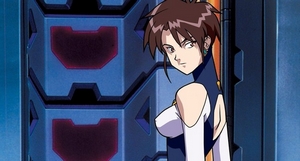Stuart:
A remake of an anime series of the late 80s (that was simply called ‘Bubblegum Crisis’), Bubblegum Crisis: Tokyo 2040 is set seven years after a massive earthquake decimated the city of Tokyo. Because of the colossal rebuilding effort required, robots known as ‘boomers’ have been employed in manual labour positions. The boomers are now so commonplace that people don’t even bat an eyelid if they knock over a glass in a restaurant; they just wait calmly for a robot to appear and clean up their mess for them.
The boomers are unstable and occasionally prone to going nuts, however, transforming into a more bestial form and taking down parts of the city. Such incidents have been downplayed by the powers that be, and the news programs simply don’t report them. (It’s never adequately explained how this can be so when the destruction is so evident.) Meanwhile, miles above the Earth in his space elevator, the head of the Genom Corporation – sole producers of the boomers – furthers his sinister agenda.
Such incidents have been downplayed by the powers that be, and the news programs simply don’t report them. (It’s never adequately explained how this can be so when the destruction is so evident.) Meanwhile, miles above the Earth in his space elevator, the head of the Genom Corporation – sole producers of the boomers – furthers his sinister agenda.
Coming to the rescue of the people of Tokyo are the Knight Sabers. A group of slinky young women who wear high tech ‘hard suits’, they spring into action whenever a boomer threatens the populace. This part of Bubblegum Crisis is perhaps the most common of anime elements – we have a group of youthful people in battlesuits that kick arse – but to be distracted by the simplicity of the concept is to miss out on all the great science fictioning going on elsewhere. The show is best described as Bladerunner meets H.P. Lovecraft. The blurring between human and machine is of paramount importance to the story, whilst some of the monstrosities that are created when boomers turn homicidal bear a certain resemblance to the Old Ones.
There are some highly memorable characters. Sylia Stingray (Satsuki Yukino) is the leader of the Knight Sabers and, in true Bruce Wayne style, a billionaire that funds their entire secret robot-fighting organisation. Priss Asagiri (Yu Asakawa) is the foremost fighter, and also moonlights as the singer of a local rock band. Taciturn and seemingly devoid of emotion, she’s the most interesting character. Nene Romanova (Hiroko Konishi) is a girly hacker genius that also works for the AD police, a legitimate unit that’s supposedly been formed to combat the growing boomer problem. Finally, Linna Yamazaki (Rio Natsuki) is the newest member of the group who gives the audience a way ‘in’ to this underground group of operatives.
The series is a great blend of thought-provoking sci-fi, well-developed characters and thrilling action sequences. Another distinguished aspect of the show is that it features the least amount of ‘fan service’ that I’ve seen in an anime series to date. Sure, the way in which the Knight Sabers slip into their hard suits is a little more than erotic, but for the most part the show is restrained, instead interested in more pressing matters – like, you know, story (take note, Strike Witches and Dance in the Vampire Bund).
The main letdown of Bubblegum Crisis: Tokyo 2040 would be the animation, surprisingly enough. Whilst I’ve seen several series that can’t match their great visuals with equally talented storytelling, this show frequently feels like corners are being cut. Thus, we are subjected to various ‘crowd scenes’ where no one is animated, and moments where the only movement comes from a post-production shuddering of the image. Oh, and it helped the animators’ ambitions’ no end that the hard suits feature opaque helmets. Thus, we get entire conversations without any facial animation whatsoever. At least the matte paintings are pretty cool.
Whilst I’ve seen several series that can’t match their great visuals with equally talented storytelling, this show frequently feels like corners are being cut. Thus, we are subjected to various ‘crowd scenes’ where no one is animated, and moments where the only movement comes from a post-production shuddering of the image. Oh, and it helped the animators’ ambitions’ no end that the hard suits feature opaque helmets. Thus, we get entire conversations without any facial animation whatsoever. At least the matte paintings are pretty cool.
I have a love/hate relationship with the design of the hard suits. They’re kinda groovy in appearance (particularly the second generation designs that appear later on), but at the same time they feature built in high heels (of course!) and the bulbous shape of the helmets looks silly. Even worse, there was the occasional moment where I simply couldn’t tell what I was looking at, purely because of the lack of detail and/or colour variation in the suits.
Whether I grew accustomed to the style or the show’s budget was increased, the skimping on animation became less and less bothersome. By the end there were frequently sequences that impressed, if only for the brilliantly audacious art design on show. As with a lot of anime, as we get towards the end of the story the narrative gets increasingly confusing and off-the-wall, to the extent that I could only really explain the conclusion of the series in the most general of terms.
These few niggles aren’t enough to sully the overall production of the show. The image on the DVDs is clear enough and the soundtrack is awesome in an oh-so-late-90s way, and whilst the special features are practically non-existent, that doesn’t detract from the sheer cyberpunk goodness that lurks within Bubblegum Crisis: Tokyo 2040. A must for anyone who likes his or her anime futuristic and challenging.
Rating:Bubblegum Crisis: Tokyo 2040 Complete Collection is available on DVD from Madman.
